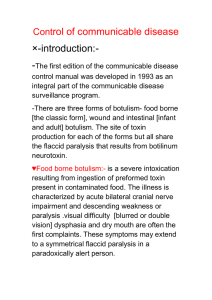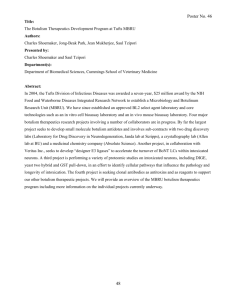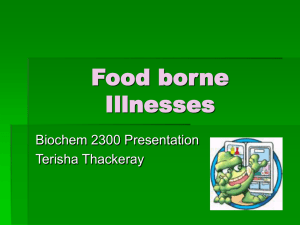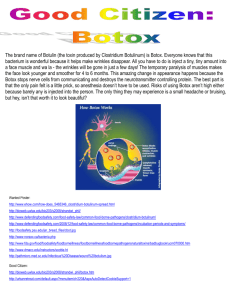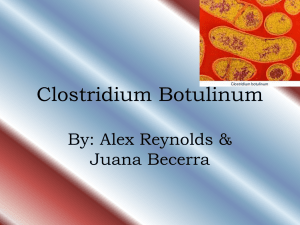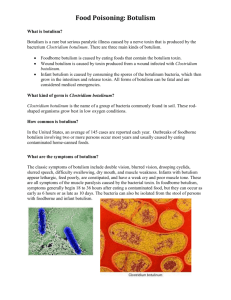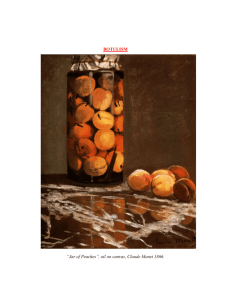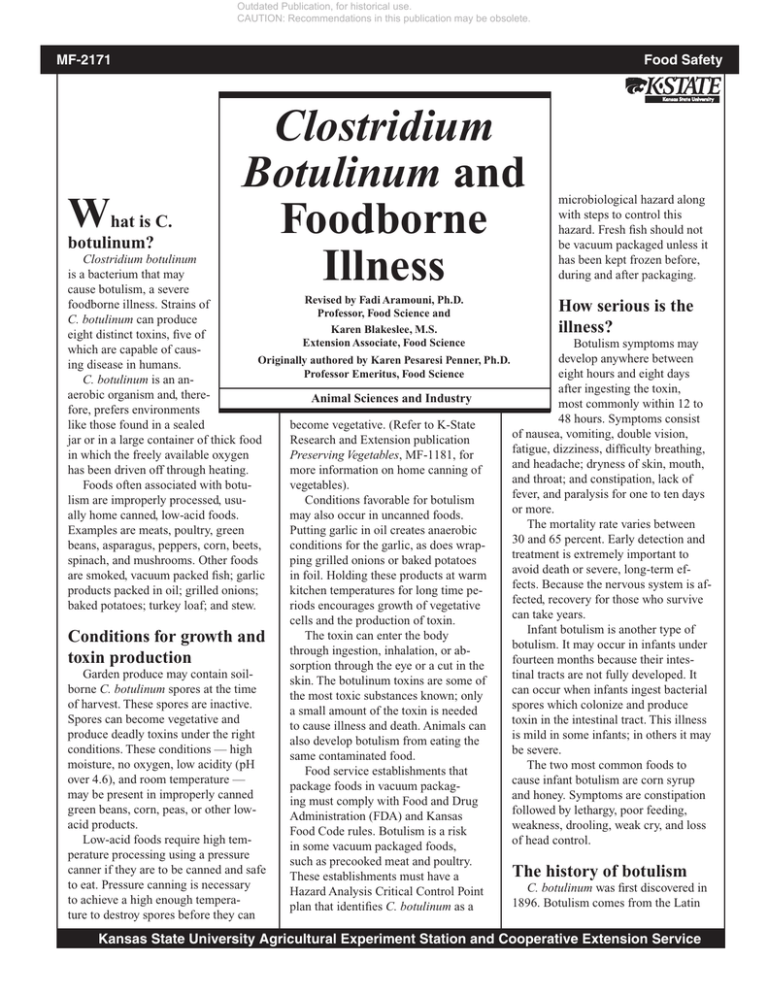
Outdated Publication, for historical use.
CAUTION: Recommendations in this publication may be obsolete.
1
MF-2171
W
hat is C.
botulinum?
Food Safety
Clostridium
Botulinum and
Foodborne
Illness
microbiological hazard along
with steps to control this
hazard. Fresh fish should not
be vacuum packaged unless it
has been kept frozen before,
during and after packaging.
Clostridium botulinum
is a bacterium that may
cause botulism, a severe
Revised by Fadi Aramouni, Ph.D.
foodborne illness. Strains of
How serious is the
Professor, Food Science and
C. botulinum can produce
illness?
Karen Blakeslee, M.S.
eight distinct toxins, five of
Extension Associate, Food Science
Botulism symptoms may
which are capable of causdevelop
anywhere between
Originally
authored
by
Karen
Pesaresi
Penner,
Ph.D.
ing disease in humans.
Professor Emeritus, Food Science
eight
hours
and eight days
C. botulinum is an anafter
ingesting
the toxin,
aerobic organism and, thereAnimal Sciences and Industry
most
commonly
within 12 to
fore, prefers environments
48
hours.
Symptoms
consist
like those found in a sealed
become vegetative. (Refer to K-State
of
nausea,
vomiting,
double
vision,
jar or in a large container of thick food
Research and Extension publication
fatigue, dizziness, difficulty breathing,
in which the freely available oxygen
Preserving Vegetables, MF-1181, for
and headache; dryness of skin, mouth,
has been driven off through heating.
more information on home canning of
and throat; and constipation, lack of
Foods often associated with botuvegetables).
fever, and paralysis for one to ten days
lism are improperly processed, usuConditions favorable for botulism
or more.
ally home canned, low-acid foods.
may also occur in uncanned foods.
The mortality rate varies between
Examples are meats, poultry, green
Putting garlic in oil creates anaerobic
30
and 65 percent. Early detection and
beans, asparagus, peppers, corn, beets,
conditions for the garlic, as does wraptreatment
is extremely important to
spinach, and mushrooms. Other foods
ping grilled onions or baked potatoes
avoid
death
or severe, long-term efare smoked, vacuum packed fish; garlic
in foil. Holding these products at warm
fects.
Because
the nervous system is afproducts packed in oil; grilled onions;
kitchen temperatures for long time pefected,
recovery
for those who survive
baked potatoes; turkey loaf; and stew.
riods encourages growth of vegetative
can
take
years.
cells and the production of toxin.
Infant botulism is another type of
The toxin can enter the body
Conditions for growth and
botulism.
It may occur in infants under
through ingestion, inhalation, or abtoxin production
fourteen
months
because their intessorption through the eye or a cut in the
Garden produce may contain soiltinal
tracts
are
not
fully developed. It
skin. The botulinum toxins are some of
borne C. botulinum spores at the time
can
occur
when
infants
ingest bacterial
the most toxic substances known; only
of harvest. These spores are inactive.
spores
which
colonize
and
produce
a small amount of the toxin is needed
Spores can become vegetative and
toxin
in
the
intestinal
tract.
This illness
to cause illness and death. Animals can
produce deadly toxins under the right
is
mild
in
some
infants;
in
others
it may
also develop botulism from eating the
conditions. These conditions — high
be
severe.
same contaminated food.
moisture, no oxygen, low acidity (pH
The two most common foods to
Food service establishments that
over 4.6), and room temperature —
cause
infant botulism are corn syrup
package foods in vacuum packagmay be present in improperly canned
and
honey.
Symptoms are constipation
ing must comply with Food and Drug
green beans, corn, peas, or other lowfollowed
by
lethargy, poor feeding,
Administration (FDA) and Kansas
acid products.
weakness,
drooling,
weak cry, and loss
Food Code rules. Botulism is a risk
Low-acid foods require high temof
head
control.
in some vacuum packaged foods,
perature processing using a pressure
such as precooked meat and poultry.
canner if they are to be canned and safe
The history of botulism
These establishments must have a
to eat. Pressure canning is necessary
C. botulinum was first discovered in
Hazard Analysis Critical Control Point
to achieve a high enough tempera1896.
Botulism comes from the Latin
plan that identifies C. botulinum as a
ture to destroy spores before they can
Kansas State University Agricultural Experiment Station and Cooperative Extension Service
Outdated Publication, for historical use.
CAUTION: Recommendations in this publication may be obsolete.
2
word “botulus,” which means sausage.
Early cases of the illness often came
from eating improperly cured sausage.
Today in the United States, sausage
is rarely the cause of botulism because
nitrites are added to prevent bacterial growth. Plant products rather than
animal products are more commonly
the source of organisms. Before 1963,
most cases of botulism in the United
States were traced to home-canned
vegetables.
Total cases rarely exceed 50 per
year, with the highest 10-year period
being from 1930 to 1939 when 384
cases were reported from noncommercial foods. Between 1899 and 1963,
1,561 cases were reported from noncommercial foods, while 219 were reported from commercial foods between
1906 and 1963. In 2003, there were
20 cases of foodborne botulism and
76 cases of infant botulism reported
in the United States to the Centers for
Disease Control and Prevention.
Botulism last occurred in Kansas
in July 1995 when an older couple
became ill from eating home-canned
food. Infant botulism last occured in
Kansas in 1996.
How can you prevent
botulism?
The majority of outbreaks have
been caused by home-canned foods.
Because C. botulinum forms heatresistant spores, home-canned meat,
poultry, fish, and vegetable products
require pressure canning to achieve a
high enough temperature (240 to 250
degrees Fahrenheit) for a sufficient
time to destroy the spores.
It is important to use research-based,
up-to-date processing methods. These
methods are described in the USDA
Guide to Home Canning, 1994, and in
various K-State Research and Extension publications.
Oven, microwave, and open-kettle
canning are definitely out! If you do
not have a pressure canner, borrow one
or freeze the food instead. If C. botulinum bacteria survive and grow inside
a sealed jar of food, they can produce
a poisonous toxin. Even a taste of food
containing this toxin can be fatal. Do
not consume food suspected to contain
botulism, even if boiled.
Caution: To prevent the risk of
botulism, low-acid and tomato foods
not canned according to the recommendations in the USDA Guide to
Home Canning or according to other
USDA-endorsed recommendations
should be boiled as above, even if you
detect no sign of spoilage. All low-acid
foods canned according to the approved
recommendations may be eaten without
boiling them when you are sure of all
the following:
■ Food was processed in a pressure
canner.
■ Pressure canner gauge was tested
and accurate.
■ Up-to-date researched process
times and pressures were used for the
size of the jar, the style of pack, and the
kind of food being canned.
■ The process time and pressure
recommended for sterilizing the food at
your altitude was followed.
■ The jar lid is firmly sealed and
concave.
■ Nothing has leaked from the jar.
■ No liquid spurts out when the jar
is opened.
■ No unnatural or “off ” odors can
be detected.
Because of the potential hazards of
improperly home-canned foods, it is
also against State of Kansas regulations
to serve these foods in food service
establishments.
■ Avoid using vacuum packaging machines to enhance storage of
leftovers.
■ Store leftover foods and vacuumpackaged meats in the refrigerator or
freezer.
■ Do not feed corn syrup and honey
to infants or use as a dip for pacifiers.
References
Adams, M.R., and M.O. Moss. Food Microbiology. The Royal Society of Chemistry., 1995, pp. 168-177.
Applied Foodservice Sanitation, A Certification Coursebook, 4th Ed. The
Educational Foundation of the National
Restaurant Association, 1992, pp. 44-45.
Jay, James M. Modern Food Microbiology,
An AVI Book. Van Norstrand Reinhold,
4th Ed., 1992, pp. 487-501.
Kansas Food Code, Kansas Department
of Health and Environment, Bureau
of Consumer Health. 1999. Subpart
3-502.12 K.A.R. 28-36-101 through
K.A.R. 28-36-108
Miller, Roger W. “How Onions and a Baked
Potato Became Sources of Botulism Poisoning.” FDA Consumer, October 1984.
Penner, Karen P. Microorganisms and
Foods. Kansas State University North
Central Regional Extension Publication
No. 447, 1992.
Summary of Notifiable Diseases – United
States 2003 www.cdc.gov/mmwr/preview/mmwrhtml/mm5254al.htm Accessed 8/28/2005
Summary of Notifiable Diseases – United
States 1996 www.cdc.gov/mmwr/preview/mmwrhtml/00050719.htm Accessed 8/28/2005
USDA Guide to Home Canning. USDA-ES
Agriculture Information Bulletin No.
539, 1994.
Brand names appearing in this publication are for product identification purposes only. No endorsement is intended, nor is criticism implied of similar products not mentioned.
Publications from Kansas State University are available on the World Wide Web at: http://www.oznet.ksu.edu
Contents of this publication may be freely reproduced for educational purposes. All other rights reserved. In each case, credit Fadi Aramouni, Karen Blakeslee and Karen P. Penner,
Clostridium Botulinum and Foodborne Illness, Kansas State University, January 2006.
Kansas State University Agricultural Experiment Station and Cooperative Extension Service
MF-2171
January 2006
K-State Research and Extension is an equal opportunity provider and employer. Issued in furtherance of Cooperative Extension Work, Acts of May 8 and June
30, 1914, as amended. Kansas State University, County Extension Councils, Extension Districts, and United States Department of Agriculture Cooperating,
Fred A. Cholick, Director.

